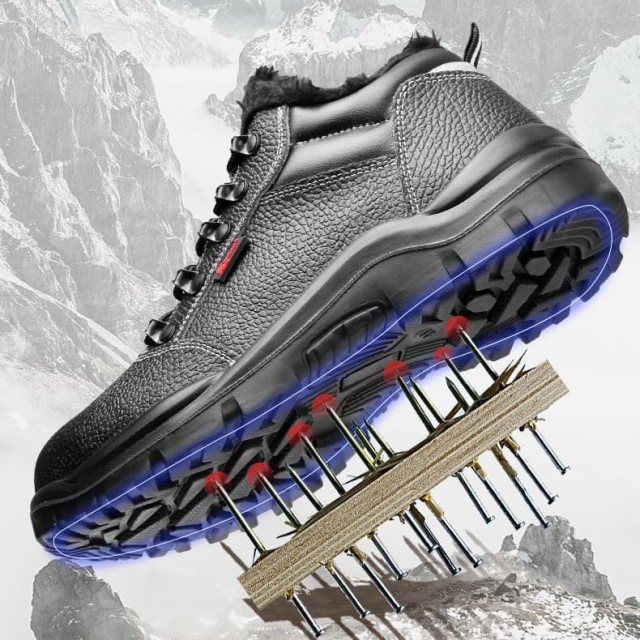Workplace foot injuries account for 7% of all occupational wounds, with slips and falls alone contributing to 44% of accidents in heavy industries. Protective footwear isn’t just about compliance—it’s a frontline defense against crushing impacts, electrical hazards, and life-altering injuries. This guide breaks down how engineered safety features like metatarsal guards and dielectric soles directly mitigate risks while ensuring adherence to ASTM F2413 and EN ISO 20345 standards.
Why Workplace Hazards Demand Specialized Footwear
Common Risks in Heavy Work Environments
From construction sites to chemical plants, workers face:
- Crush injuries from falling tools or rolling equipment
- Puncture wounds caused by nails, metal shards, or broken glass
- Electrical shocks in environments with exposed wiring
- Chemical burns from spills or splashes
- Slip-and-fall accidents on wet or oily surfaces
A single misstep without proper protection can lead to lost workdays, chronic pain, or permanent disability.
Safety Standards and Compliance Requirements
Regulations like ASTM F2413-2005 mandate rigorous testing for:
- Impact resistance (withstands forces up to 75 ft-lbs)
- Compression protection (handling loads over 2,500 lbs)
- Electrical hazard (EH) ratings (blocks up to 18,000 volts)
Employers must conduct job-specific hazard assessments to select footwear that matches risks—steel toes for warehouses, dielectric boots for electricians, or chemical-resistant soles for labs.
Key Features of Protective Footwear
Material Durability and Impact Resistance
- Steel/composite toe caps disperse impact energy, reducing fracture risks by ~60% in drop tests.
- Kevlar-lined midsoles prevent punctures from sharp objects penetrating the sole.
- Heat-resistant outsoles withstand temperatures exceeding 300°F in foundries or welding shops.
Slip-Resistant Outsoles and Electrical Hazard Protection
- Microgroove tread patterns enhance traction on oily surfaces, cutting slip-related injuries by half in food processing plants.
- Non-conductive materials (e.g., rubber composites) insulate against live circuits, critical for utility workers.
- Static-dissipative designs prevent sparks in explosive environments like grain silos.
Real-World Impact of Protective Footwear
Case Study: Reducing Injury Rates in Construction
A Midwestern construction firm reported a 72% drop in foot injuries after switching to ASTM F2413-compliant boots with metatarsal guards. Workers avoided:
- Broken bones from dropped scaffolding parts
- Lacerations from exposed rebar
- Electrocution near temporary power lines
Cost Savings from Accident Prevention
- Medical expenses for a single foot injury average $40,000–$90,000, far outweighing PPE costs.
- Companies using certified safety footwear see 20–30% lower workers’ comp claims annually.
Ready to Equip Your Team with Reliable Protection?
3515 manufactures certified safety footwear for distributors and bulk buyers, combining cutting-edge materials with rigorously tested designs. From EH-rated boots to slip-resistant soles, our solutions help you safeguard workers while reducing liability risks.
Contact 3515 today to discuss custom footwear tailored to your industry’s hazards.
Related Products
- Wholesale Customizable Suede Safety Boots - Puncture-Proof with Velcro Closure
- Customizable Anti-Smash Safety Boots for Wholesale & Private Label Manufacturing
- Puncture-Resistant Velcro Safety Boots for Wholesale & Custom Manufacturing
- Durable Leather Moc Toe Work Boots for Wholesale & Custom Manufacturing
- Durable Moc-Toe Wedge Work Boots | Wholesale Manufacturing for Brands
Related Articles
- How to Choose Work Boots That Match Your Job Demands and Safety Needs
- Matching Men’s Work Shoe Safety Technologies to Workplace Hazards
- How to Choose Work Boots That Balance Safety, Comfort, and Durability for Your Job
- How to Choose Work Boots That Match Your Job's Safety Demands
- How to Choose Work Boots That Match Your Industry's Safety Needs



















